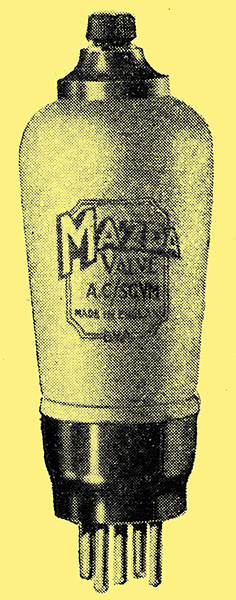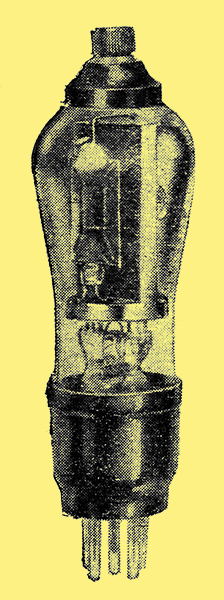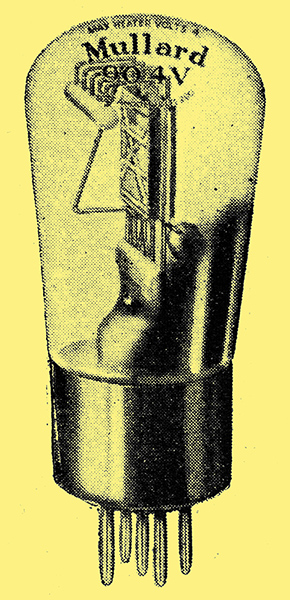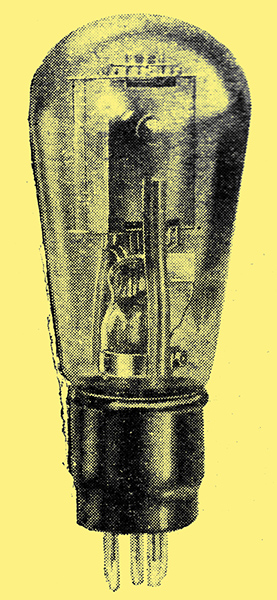|
After the plethora of new, valve types of the last two years, valve makers and valve users may well be grateful for an apparent lull in the flow of inventions, permitting the time for improvements in design and a general consolidation oi the new positions. The benefits are already obvious in greater consistency among specimens of the same type, in the achievement of rigidity of construction and in the almost complete conquest of microphonic noise. Whilst there are not any noteworthy new principles introduced, there will be found some important improvements and additions to the series already existing.
There is good news for the DC user, who can now take his choice from a number of HF, detector and small output valves quite equal in efficiency to those used in modern AC sets. Detector valves with low input impedance due to a reduction of inter-electrode capacity have just made their appearance and should assist in improving the selectivity of a receiver by virtue of a decrease in damping of the tuned grid circuit.
In the output range the pentode shows no sign of waning in popularity, will be evident from a visit to any of the valve manufacturers' stands.
HF Valves

Mazda AC/SGVM - a new high-slope variable-μ valve for AC mains.
The variable-μ valve seems to have almost entirely superseded the ordinary screen-grid valve. This is only natural as there no function which the SG valve can perform which cannot be better carried out by the variable-μ type. Of newcomers belonging to this class mention should be made of the Mazda AC/SGVM, having a slope of 2.2 mA/Volt and a generous grid of about 4 5 Volts, ensuring a full control of volume from zero to a high maximum. Special care has been taken in so designing the screen feed potentiometer advocated for this valve that the screen volts rise considerably above the mean level between -4 and -10 Volts bias where cross-modulation might otherwise make its appearance. The new Mullard valve of variable conductance is styled the VM4V and is very sensitive at low bias voltages.
There are a number of 2 Volt battery variable-μ valves now available. In addition to the Cossor 220VSG, which was the first of its type on the British market, the Marconi and Osram VS2 (mutual conductance 1.1), the Mazda S215VM (mutual conductance 2.0) and the Lissen SG2V (mutual conductance 1.7) have now been developed.

Osram VDS, an indirectly heated variable-mu valve for DC mains.
The user of DC lighting mains will welcome the news that he can now design an HF variable-μ amplifier containing valves which will be in no way inferior to the AC type. The new Marconi and Osram VDS is an indirectly heated DC valve consuming 0.25 Amp at 16 Volts, being a counterpart to the latest VMS4 with a slope of 2.4. Owing to certain properties of the screening grid it is advisable to use the same compensated feed arrangement as that already published for the VMS4, but the resistances should have half the normal value.
A simple circuit can be employed with this series of DC valves comprising independent automatic grid bias in the cathode lead of each valve the heater-cathode insulation is quite unaffected by a difference of potential up to 110 Volts. Another variable-μ valve with indirectly heated cathode for DC mains is the Mazda DC/2SGVM, having a heater to carry 0.1 Amp. at 20 Volts and the high mutual conductance of 2.2 mA/Volt.
Detectors

Muilard 904V - a special AC detector valve having a low input impedance.
There are signs of a slight revival of anode bend rectification in the second detector position in superheterodynes, and there is an increasing use of the screen grid valve as detector in straight sets, but interesting as these developments are, they do not call for the manufacture of new valve types.
As a power grid detector the new Mullard 904V will be of considerable interest, for not only has a new rigid unit construction been embodied which completely defeats microphonic troubles, but also in designing the electrodes the makers have paid special attention to residual capacity, with the result that the input impedance is considerably reduced and damping of the preceding tuned circuit is thereby minimised. The Mullard PM1HL a valve which has gained considerable popularity as a detector - has been redesigned both mechanically and electrically and is most sensitive at 20 to 50 Volts HT. As a consequence it is extremely economical in anode current.
The Standard Micromesh type HLA1 is a new detector for AC mains with the remarkable mutual conductance of 8 mA/Volt. In this valve and others of the series, close spacing of electrodes has been reduced to a fine art, and in spite of clearances which have hitherto been considered impracticable, the valves stand up to rough usage and a system of cooling fins ensures freedom from grid emission. The anode-to-grid capacity in the HLAI is only 5 pF, which is reflected back to the input side as quite a small impedance.
Little modification is being made to the well known detectors already on the market. and the following, which are representative of their class, will be retained for the coming season: The Cossor 41MHF and 41MHL, Marconi and Osram MH4, Mazda AC/HL and AC2/HL, and Mullard 354V.
Output Valves

Cossor PT41B, a new directly heated pentode with an anode dissipation of 12 Watts.
The most striking additions to this class are undoubtedly a series, of pentodes, the sensitivity and mutual conductance of which will be seen to be of a very high order. Directly heated pentodes for AC mains will be conspicuous and a number of well known set makers are including them in their more ambitious products. The redesigned Marconi and Osram PT4 has a directly heated filament (4 Volts 1 Amp) and is rated for 250 Volts on both screen and anode. Its mutual conductance nearly 3 and the anode dissipation 8 Watts. Another directly heated pentode which will find ready application in ambitious radio-gramophones and amplifiers for public entertainment is the Marconi and Osram PT25, requiring 2 Amps at 4 Volts for the filament. The maximum dissipation is 25 Watts, about 40% of which can be extracted as undistorted AC output. In the Cossor range the PT41 and PT41B are new pentodes of the directly heated type with liberal outputs. The second of these has a dissipation of 12 Watts and will feed satisfactorily the largest type of moving-coil speaker. Other new output valves of interest are the Mazda PP3/250 and the DC/2P for AC and DC mains respectively. The former has a slope of 6.5 and will dissipate 12 Watts, while the latter has a heater demand of 0.1 Amp. at 35 Volts, ensuring extremely economical running.

The record mutual conductance of 12.6 mA/Volt is obtained in the Standard Micromesh PA1 output valve. This illustration shows the cooling fins and the close-spaced electrodes.
One of the most outstanding valve exhibits will be the standard Micromesh PA1 with the record mutual conductance of 12.6. No less than 1¾ Watts AC output can be obtained with 11 Volts bias and 200 Volts on the anode, these exceptional characteristics being obtained by small clearances.
Mains Rectifying Valves
Little change has taken place in the range available; for the good reason that the standardised types A, B and C developed last season have met practically every demand in receiver design. Both in the directly and indirectly heated types the makers have paid attention to slow heating, thus minimising the effect of high initial voltages on switching on. There is extended use of the hot cathode mercury vapour rectifier where the total current required is beyond the capabilities of the three, ordinary standardised types. A new rectifier is being marketed by Standard Telephones and Cables styled the Micromesh R1 giving nearly 300 Volts DC at 60 mA.
|